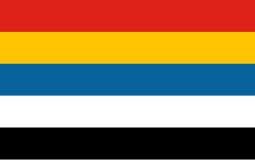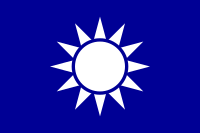Five Races Under One Union
| Five Races Under One Union | |||||||||||||||||||||||||
|---|---|---|---|---|---|---|---|---|---|---|---|---|---|---|---|---|---|---|---|---|---|---|---|---|---|
 The center flag is the Five-Colored Flag of the Republic of China. Underneath the three flags is the message: "Long live the union" (共和萬歲). | |||||||||||||||||||||||||
| Chinese | 五族共和 | ||||||||||||||||||||||||
| Literal meaning | five ethnic groups living together in mutual harmony (the res publica) | ||||||||||||||||||||||||
| |||||||||||||||||||||||||
Five Races Under One Union was one of the major principles upon which the Republic of China was founded in 1911 at the time of the Xinhai Revolution.[1][2][3][4] Its central tenet was the harmonious existence under one nation of what were considered the five major ethnic groups in China: the Han, the Manchus, the Mongols, the Hui, and the Tibetans.
 | |
| Name | "Five-colored flag" (五色旗) |
|---|---|
| Use | Civil and state flag |
| Proportion | 5:8 |
| Adopted | 10 January 1912 |
| Design | Five horizontal bands of red, yellow, blue, white and black. |
Description[]
This principle emphasized harmony between what were considered the five major ethnic groups in China, as represented by the colored stripes of the Five-Colored Flag of the Republic: the Han (red); the Manchus (yellow); the Mongols (blue); the Hui (white); and the Tibetans (black).[5]
The term 回, huí, primarily referred in this context to Muslims, as a whole,[6] and as such for a certain period of time (before the Xinhai Revolution) the term also referred to the Uyghurs in Western China, since the term "Muslim Territory" (回疆; Huíjiāng) was an older name for Xinjiang during the Qing dynasty.[7] The meaning of the term "Hui people" gradually shifted to its current sense—a group distinguished from Han Chinese by their Muslim faith and distant foreign ancestry—around 1911–49 in the Republic of China.
Colors scheme |
Blue | Red | Yellow |
|---|---|---|---|
| Pantone | 307 C | 2347 C | 7548 C |
| CMYK | 99-37-0-38 | 0-88-92-13 | 0-22-100-0 |
| HEX | #02639D | #DF1B12 | #FFC600 |
| RGB | 2-99-157 | 223-27-18 | 255-198-0 |
History[]
Historical records from the Sui dynasty show a system of military banners using the five colors to represent the Five Elements: red for fire, yellow for earth, blue for wood/wind, white for metal, and black for water. The Tang dynasty inherited this system, and has arranged the colors in a united flag according to the above order of the elements, for military use. In the Liao and Song periods, the Khitan people used the same flag design, as depicted in Chinese painting. During the reign of the Mongol Yuan dynasty the five colors started to symbolize ethnicities (五色四夷) in a multiethnic state. In later historical periods, this "flag of the five united elements" was altered and readapted for military and official uses. A Qing dynasty painting depicting the Banners victory over the Muslim Du Wenxiu rebellion in Yunnan, includes a Qing military flag with the five elements arranged in the order of yellow, white, black, green and red.

After the Wuchang uprising, the Qing dynasty regime was replaced by the Republic of China. Prior to the adoption of the five colors flag by the Republic, a number of different flags were promoted by revolutionaries. For example, the military units of Wuchang wanted a 9-star flag featuring a Taijitu symbol,[5] while Sun Yat-sen preferred the Blue Sky and White Sun flag to honor Lu Haodong.[5]

Despite the uprisings targeting a Manchu-dominated regime, Sun Yat-sen, Song Jiaoren and Huang Xing unanimously advocated racial integration, which was symbolized by the five-color flag.[8] They promoted a view of the non-Han ethnicities as also being Chinese, despite them being a relatively small percentage of the population.[9]
The "five ethnic groups under one union" flag was no longer used after the Northern Expedition ended in 1928.
A variation of this flag was adopted by Yuan Shikai's empire and the Japanese puppet state of Manchukuo (see Flag of Manchukuo). In Manchukuo, a similar slogan (五族協和) was used, but the five races it represented were the Yamato (red), Han Chinese (blue), Mongols (white), Koreans (black) and Manchus (yellow). Some of its own variations also made the yellow more prominent, rather than display each color equally.
During the Second Sino-Japanese War, the flag was used by several Japanese puppet governments, including the Provisional Government of the Republic of China in the northern part of the country and the Reformed Government of the Republic of China in central China.
Gallery[]
China[]

National flag, 1912–1928 (used again by the Provisional Government, 1937–1940 and Reformed Government, 1938–1940)

Beiyang Army insignia, 1912–1928

National flag of the Empire of China, 1915–1916

Air force roundel, 1920–1921

Commander-in-chief flag of the Republic of China (Beiyang Government), 1927–1928

Reformed Government Army insignia, 1938–1940

One of the proposed national flags of the People's Republic of China, August 1949
Inner Manchuria[]

Manchuria Aviation Company roundel, 1931–1945

National flag of Manchukuo, 1932–1945

War ensign of Manchukuo, 1932–1945

Manchukuo Army insignia, 1932–1945

Manchukuo Air Force roundel, 1937–1945
Inner Mongolia ("four races")[]

Mongol Military Government banner, 1936–1939

South Chahar Autonomous Government banner, 1937–1939

North Shanxi Autonomous Government banner, 1937–1939

Flag of Mengjiang, 1939–1945
See also[]
Notes[]
References[]
- ^ Murray A. Rubinstein (1994). Murray A. Rubinstein (ed.). The Other Taiwan: 1945 to the present (illustrated ed.). M.E. Sharpe. p. 416. ISBN 1-56324-193-5. Retrieved 28 June 2010.
- ^ James A. Millward (2007). Eurasian crossroads: a history of Xinjiang (illustrated ed.). Columbia University Press. p. 208. ISBN 978-0-231-13924-3. Retrieved 28 June 2010.
- ^ Paul Hibbert Clyde, Burton F. Beers (1971). The Far East: a history of the Western impact and the Eastern response (1830–1970) (5, illustrated ed.). Prentice-Hall. p. 409. ISBN 9780133029765. Retrieved 28 June 2010.CS1 maint: uses authors parameter (link)
- ^ Making of America Project (1949). Harper's magazine, Volume 198. Harper's Magazine Co. p. 104. Retrieved 13 June 2011.
- ^ a b c Fitzgerald, John. [1998] (1998). Awakening China: Politics, Culture, and Class in the Nationalist Revolution. Stanford University Press publishing. ISBN 0-8047-3337-6, ISBN 978-0-8047-3337-3. pg 180.
- ^ "China's Islamic Heritage". 5 March 2006.
The Nationalist government had recognised all Muslims as one of "the five peoples"—alongside the Manchus, Mongols, Tibetans and Han Chinese—that constituted the Republic of China
- ^ Suisheng Zhao (2004). A nation-state by construction: dynamics of modern Chinese nationalism (illustrated ed.). Stanford University Press. p. 171. ISBN 0-8047-5001-7. Retrieved 12 June 2011.
- ^ Hsiao-ting Lin. [2010] (2010). Modern China's ethnic frontiers: a journey to the west. Taylor & Francis publishing. ISBN 0-415-58264-4, ISBN 978-0-415-58264-3. pg 7.
- ^ Chow, Peter C. Y. [2008] (2008). The "one China" dilemma. Macmillan publishing. ISBN 1-4039-8394-1, ISBN 978-1-4039-8394-7. pg 31.
- Chinese nationalism
- Flags of China
- Politics of the Republic of China (1912–1949)
- Ideology of the Kuomintang
- 1911 Revolution
- Flags displaying animals
- Rainbow flags
















